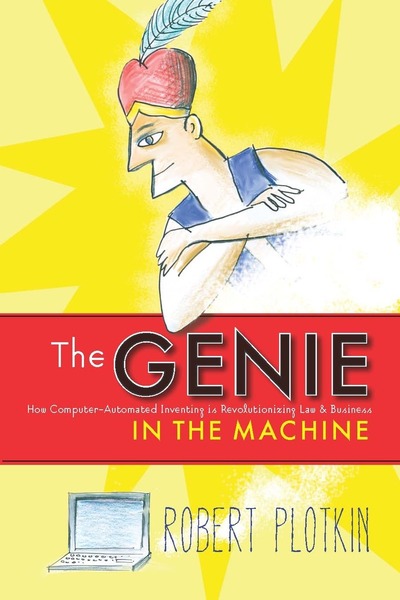The following is an interview transcript with Robert Plotkin about software patents for AI.
Robert is a pioneer and thought leader in the AI space. He is also the author of “The Genie In The Machine,” (2009) which predicted the current impact of AI today.
Attorney Plotkin has also been a leader in obtaining software patents for clients for two decades. He has consistently obtained software patents for clients even after the Alice Supreme Court decision stopped many companies from obtaining software patents.

1. Tell us more about yourself and your background.
I’m a patent attorney and have been specializing in software patents for over 25 years. I obtain patent protection for cutting-edge software in fields such as artificial intelligence (AI), quantum computing, and autonomous vehicles for leading technology companies, universities, and law firms worldwide. I’m an MIT-educated computer scientist and use both my technical and legal expertise to obtain patents that have maximum value for my clients. His clients have profitably sold and licensed the software patents he has obtained for them to major corporations worldwide.
I have helped my clients profitably sell and license the software patents I’ve obtained for them to major corporations worldwide. Besides being an attorney, I am also an innovator. I am a named inventor and owner of over 25 patents and patent applications, many of which have been successfully licensed to leading multinational corporations.
Long before AI and AI patents became a hot topic, I wrote a book on the impact of AI on innovation and the patent system called The Genie in the Machine: How Computer-Automated Inventing is Revolutionizing Law and Business, published by Stanford University Press in 2009. I use the strategies I described in that book to obtain and enforce AI patents for my clients.
My expertise in the field has been recognized by the National Law Journal. They named me an IP Trailblazer, and I have also been designated an intellectual property Super Lawyer by Thomson Reuters.
2. What is a software patent and how does it work? How is it different from other kinds of patents?
In general, a patent is a legal protection that gives an inventor (or company) a legal right. This right stops others from making, using, or selling the invention without the patent owner’s permission. This is similar to copyright protection gives the author of a novel the right to block others from copying and selling the novel without the author’s permission. Patents are very valuable for protecting the ability of innovators to earn a return on their investment before competitors can make and sell competing products by copying the innovator’s invention.
Software patents vs Other patents
A software patent is a patent that protects software. Although in theory software patents are the same as other kinds of patents, in practice they differ from other kinds of patents in some critical ways.
For example, writing and understanding software patents requires a thorough understanding of computer science. When patent attorneys who do not have a background in computer science attempt to write software patents, they often write those patents in a way that makes them too narrow and too easy for a competitor to work around. What this means is that a competitor can sell software that is only very slightly different from the patented invention and avoid infringing the patent. This can defeat the purpose of the patent and make it essentially worthless to the patent owner. In contrast, a patent attorney who has a background in computer science can write the patent in a way that is broad enough to cover a wide variety of attempts by competitors to avoid infringing the patent. This makes the patent much easier to enforce and more valuable.
Another difference between software patents and other patents is that software patents usually cover processes, rather than physical products. Patent law and the US Patent Office have developed a variety of special rules that apply to process patents. Patent examiners often reject software patents based on these special rules. Responding to these rejections in order to obtain the patent requires expertise in the rules that apply to process patents. This is another reason why software patents should be handled by patent attorneys who have special expertise in both computer science and software patents specifically.
3. What role can patents play in protecting IP for AI technology?
Patents can be extremely valuable for protecting new kinds of AI and for protecting innovations that are created using AI. In fact, most people, including many patent attorneys and many high-tech entrepreneurs, are not aware of all of the ways in which they can obtain patent protection for their AI-related innovations. The risk of this lack of awareness is that companies that innovate using AI can inadvertently fail to obtain all of the patent protection that they need. This can result in making it possible for their competitors to knock them off without recourse.
I recently wrote a blog post explaining seven different aspects of AI innovations that can be patented. If you create a new type of AI technology or you create something new using AI and you’re not aware of all of these options for patenting your invention, you might just pick one aspect of your invention to patent, and inadvertently fail to patent other aspects of your invention that could be extremely valuable to patent. As a result you could leave a significant amount of protection on the table for your competitors to exploit.
For example, most AI these days using some kind of trained model, such as a trained neural network. It is often possible to patent:
- The process of training the model. A patent on this gives the patent owner the ability to stop anyone else from training a model using the same process.
- The trained model itself. A patent on this gives the patent owner the ability to stop anyone else from making, using, or selling the same trained model.
- The process for executing the model. A patent on this gives the patent owner the ability to stop anyone else from using the same process to execute the model.
- The output of the model. A patent on this gives the patent owner the ability to stop anyone else from making, using, or selling same output of the model. If the output of the model is a design for a physical product, then you could patent that product. This kind of computer-generated invention is what my book focused on.
- The process for retraining/updating the model. A patent on this gives the patent owner the ability to stop anyone else from updating the model using the same process.
- The process for refining the output of the model. A patent on this gives the patent owner the ability to stop anyone else from using the same process to refine the output of the model.
- The final (refined) output of the model. A patent on this gives the patent owner the ability to stop anyone else from making, using, or selling the same model output.
Most people aren’t aware of all of these options for patenting their AI-related inventions. As a result, they just attempt to patent whatever seems the most innovative to them. This might not be the most valuable invention to patent from a legal or business perspective.
4. What is your position on the current copyright infringement issue in relation to Generative AI music/art?
I focus primarily on patents, so I haven’t looked into this issue in detail. However, I am in favor of finding ways to make sure that AI developers respect the copyrights of creators. This includes obtaining their permission for using their copyrighted works to train AI models and compensating them for using their copyrighted works to train AI models.
5. How do you see the AI industry evolving in the next few years?
It’s extremely hard to make predictions in a field that advances so rapidly, but here are a few thoughts:
- AI will be used to significantly reduce the amount of effort required to generate routine text and image content. The first field that is seeing the most attention is marketing, but others are sure to follow. Writers of all kinds would benefit from learning how to leverage AI tools to augment their writing capabilities.
- AI is likely to be used to automate many routine tasks involved in software development. This will enable experienced software developers to develop software more efficiently. Additionally, it will enable people without previous software development experience to create their own applications.
- Businesses will use AI to mine data, to answer questions and to generate content based on their own data. Many companies are already starting to do this, and I think we will see this trend expand significantly once Microsoft rolls out its AI Copilot system to a wider audience soon. Savvy businesses will leverage this ability to make their operations more efficient. They will also ensure that AI-generated content is created in ways that are consistent with and promote the business’ brand.
- Language models such as GPT will be used at the core of applications. These applications will be much more complex than ChatGPT and anything we’ve seen so far. Imagine applications that can execute complex algorithms that use language models such as GPT. They perform individual operations and to iterate over them thousands or millions of times to automate complex processes. ChatGPT will seem like a toy in comparison to tools like this.
- Dedicated AI hardware and algorithms improvements will enable applications such as ChatGPT to speed up by 1000x in the future. This will enable the applications mentioned above to become much more powerful and to operate much more quickly.
Companies that don’t implement AI into their processes soon run the risk of falling behind their AI-savvy rivals.
Check out more AI tools.
Sign up for AI membership.
